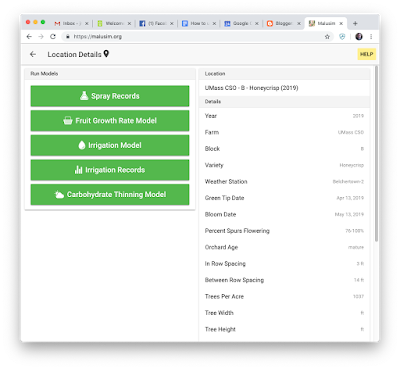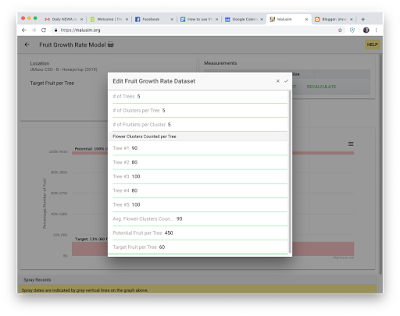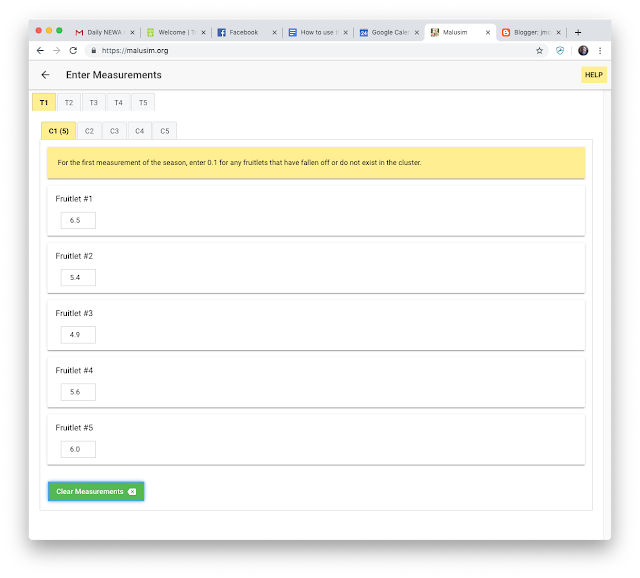Yes, my blog seems to be heavy on #IFTA (
International Fruit Tree Association) posts. Probably because it's one of the more interesting, and photogenic things I do all year? mine pales in comparison to coverage by Good Fruit, Growing Produce (American Fruit Grower), and Fruit Growers News (see links at end), but it's a good exercise for me to document. Make sure you also check out #iftaontario on Twitter.
#IFTAONTARIO Headquarters, Hamilton, Ontario, CANADA, a port city of just over half-million people on the west shore of Lake Ontario. Major economy is manufacturing and is the steel capital of Canada. We got the impression it is a diverse city too, 25% of the population was not born in Canada. (Curious how that compares to major U.S. cities?) A real interesting and copiously stocked food store housed in the mall below the Sheraton hotel called
Nations Fresh Food...and had some pretty nice calamari (and margaritas) at a Mexican restaurant called
TheMule. Dinner company with Lisa Jenereaux (IFTA President) and Pedro Cuevas, Semios Washington Account Manager. I learned a lot about
Semios Automated, Remotely Controlled Climate, Insect and Disease Monitoring and Treatment.
 |
| Yummy fried calamari at TheMule in Hamilton |
DAY 1 -- Orchard tours in the Norfolk region, mostly west of the Niagara escarpment.
Stop 1: University of Guelph Research Station with U. of Guelph Dr. John Cline and OMAFRA's (Ontario Ministry of Agriculture, Food, and Rural Affairs) Amanda Green. Dr. Cline discusses preliminary results of 2014 NC-140 Honeycrisp apple rootstock planting featuring Vineland and Geneva rootstocks. Here is a
preliminary report prepared by Dr. Cline. From the report "V.5, V.6, and V.7 appear to be more vigorous and slightly less yield efficient (than G. 935), but offer cold hardiness and resistance to fireblight (rootstock not scion resistance)." Also see the
planting page on
nc140.org. And Amanda Green told us about the significant parternships in Canada to develop and test new apple varieties. We also made a quick stop at a cider variety planting/trial as there is significant interest in apples for making quality ciders in Canada (as well as the U.S.).
 |
| Dr. John Cline with the cider apple variety planting |
 |
| OMAFRA's Amanda Green talks about new apple variety evaluations |
Stop 2: Hedges Apples, wow, owner and IFTA Director Chris Hedges is managing 250 acres of apples (including 75 acres of new plantings) as well as owning and operating
Ontario Orchard Supply. Formerly a banker, you can tell Chris is into analyzing all aspects of his operations. And I doubt he works bankers hours anymore! We had lunch in his brand new 10,000 bin CA cold storage. At Hedges Apples, we were also treated to a demonstration of Crop Adapted Spraying by showman Dr. Jason Deveau, OMAFRA Application Technology Specialist. I won't get into the details, you can see much, much more at
sprayers101.com but I did like that H.S.S. "airblast" sprayer. After listening to Jason, I hesitate now to call it an "airblast" sprayer though.
 |
| Chris Hedges elaborates on his many jobs running 250 acres of apples plus Ontario Orchard Supply |
 |
| Dr. Jason Deveau makes spray depostition entertaining but with an important message! |
Stop 3: After lunch at Hedges new cold storage, we made a non-orchard stop at
Northland Ginseng Farms. Ontario can produce a high-quality Ginseng root, but the challenges are many, including land availability (crops have to be rotated after a 4-5 year growing cycle) and Chinese competition of inferior quality ginseng, according to the farmer. But Phil Schwallier sure seemed interested?
 |
| "Hey, this looks even harder than growing apples, maybe?" says Phil Schwallier of ginseng. |
Stop 4: On to
Norfolk Cherry Company, where a scheduled tour of the tart cherry packing company was put on logistical hold. We spent most of our time looking at a young (planted 2018), free-standing Honeycrisp block on V.1 rootstock. I have no pictures, which maybe says something -- it was not bad, but could have just as easily been a free-standing young tart cherry planing if you get my drift. Will be interesting to see how it turns out?
Stop 5: Last stop for the day was
Lingwood Farms. A bit of a downer because co-owner Ken Porteous has no real good succession plan in place right now, despite the orchard having been around since the mid-1800's. Still, a solid, good, well-executed orchard despite some recent challenges with a tornado (support sytem held up), fire blight, and black stem borer. (I'll put my 2 cents in here and say it's really not the black stem borer that is the problem, it's something else -- cold injury, wet feet, canker? -- weakening the trees and making them susceptible to invasion by the ambrosia beetles. Chicken-egg? Egg- Chicken? IMHO.) We looked at Ken's 3rd-leaf Gala tall-spindle "tipped"trees, AKA Wafler system. Seems to me there was pretty good approval of it...
 |
| The IFTA crowd gathers at Lingwood Farms to listen to Ken Porteous discuss his recent orchard challenges |
 |
3rd-leaf tall-spinde "tipped" Gala apple trees at Lingwood Farms
|
DAY 2, beginning with two-hour bus ride to Georgian Bay.
The ride was not too bad as the Ontario countryside -- once out of the greater Toronto metro -- was quite lovely.
Stop 1: To No End. Not remembering a lot here, the manager was a bit of a character, was not afraid to tell it like it is/was. I have minimal notes, so I don't remember too many details, but he was doing his own (I think) two-leader apple trees. This was a no-nonsense orchard, that overall looked good as did the 2-leader trees. I thought anyways. Maybe I was just a bit groggy after the bus ride?
 |
Looks like Leslie Huffman (OMAFRA, retired, and barn quiltand vinegar lady)
leads the discussion at To-No-End |
 |
| Two-leader and Gala block at To-No-End. Nice...weather. |
Stop 2: Sandy Creek. After a wonderful lunch at a private ski lodge/club,
manufactured orchard from Italy at Sandy Creek. Planted this year. Want one? Order it up --
frutop.it. Might be hitting $70,000 per acre complete with
cement posts, wire, irrigation (trickle and overhead for frost protection), and hail net. (Want DIY cement posts?
http://www.producetech.com/en) Includes installation. 30 acres? (Was suppose to be 60, but could not get it done this year.) Can't remember, don't think trees were included, but they are included in that app. 70 grand price tag. (I may be on the high side, but I think it's close. So what if it was more like $60,000?) Solid Honeycrisp, I think the plan was to install some pollinators. Some trees were flagging a bit which would concern me. Interestingly, the manager was a field crop guy (corn and soybeans) so this was all new to him. Their consultant was notably absent but I guess he only spoke Italian so that was kind of a no-starter. I don't know, will be interesting to see if they can make any money before the Honeycrisp market goes south. (If/when it ever does?) Kudos to them if it works out.
 |
| Explanation of process and costs associated with manufactured orchard by fruitop.it at Sandy Creek. |
 |
| Nice place to stand and enjoy the shade provided by hail net. Outstanding looking, but prepare to get out the big checkbook. Note a couple trees on right are not looking so good, would concern me after spending that much money. Fire blight? Site issue? Phytophthora? Not sure... |
Stop 3. Apple Springs Orchard with frequent IFTA travler
Kyle Ardiel (and father Shane). Another cooperative apple variety trial planting, and a vjust-planted, rather experimental IMHO, V-trellis apple block that included a new Honeycrisp strain from U. of Minnesota with presumably redder sking color? Kyle represents a new generation of apple farmers given the latitude by their parents to try out new ideas while continuing with the family orchard. Best wishes to the young growers, we hope they continue the two-way learning relationship with IFTA.
 |
| Young, experimental V-trellis, including spring-grafted, numbered red-strain Honeycrisp from U of MNat Apple Spring Orchard. |
Stop 4. T & K Ferri Orchard, including dinner in the orchard. Tom Ferri is a hard-working, rather animated character who's life appears to be his orchard. Tom has been cultivating super-spindle trees for a while now, and in a harsh environment up there has recently suffered some tree loss to SAD (more on that later), but overall the manicured orchard looked fantastic. Tom and a computer-savy partner lead a discussion on precision thinning using the fruitlet growth rate model. Karen hosted a catered "communal" dinner in the orchard which was a delicious and perfect way to end Day 2 of #iftaontario. Very satisfied. Sharing some wine with good company/friend and MSU Extension Agents Amy-Irish Brown and Phil Schwllier helped. I learned Phil likes his Kentucky Fried Chicken while on the road back home!)
 |
| Tom Ferri (right) and collaborator talk about how they modified the apple fruitlet growth rate model to suit their needs. They did the procedure on many blocks with mixed results. Typical of chemical thinning anomalies that everyone experiences! Got to have a bit of luck thrown in the mix to get it perfect! In other words, "precision" is a bit of an oxymoron! Weather rules! |
 |
| Beautiful super-spindle Gala at T&K Ferri Orchards. Maybe a little over-thinned, eh? Otherwise perfect! |
FINAL DAY 3, including return to Hamilton.
First, a couple stops in the morning while departing Georgian Bay.
Stop 1. Botden Orchards. Equipment display and description of operation of each -- which of course had all the guys (and maybe a few gals?) typically oohing and aahhing, equipment displays always a big hit at these IFTA tours -- by owner Marius Botden. And then a quick discussion about smaller tools used in the orchard to assess fruit quality and growing conditions (soil moisture) byMost notably -- I think, I'm not an equipment guy! -- Boden Orchards is the exclusive grower of the
Red Prince apple, which is a trademarked strain of Jonagold from Belgium. A very engaging stop overall.
 |
| Marius Botden at beginning of equipment discussion, Botden Orchards. That rather ET-like contraption in the background is an over-the-row sprayer. Marius is afraid of heights, so he has never been up in the "cabin!" |
 |
| Gerbe Botden talks about some tools used to monitor orchard conditions and fruit quality while IFTA Board member Jim Engelsma listens intently. |
Stop 2, and last stop in Georgian Bay before heading back to Norfolk regions, was Bamford Family Farms where OMAFRA's Kristy Grigg McGuffin talked about SAD/RAD, Sudden Apple Decline/Rapid Apple Decline (the latter seems to be preferred, otherwise it is just too sad). Seems this pheomenah of Rapid Apple (tree) Decline is caused by a series of environmental insults that might include winter injury, poor site conditions, and plant pathogens (including fire blight). Young- to middle-aged on dwarfing rootstocks pushed to the limits of production seem to be most afflicted. (But of course there are many such healthy trees too.) Bottom line -- no easy answer, keep trees happy and fingers crossed. Oh and it's all about Location, Location, Location I think. :-) Throw in some good management too. We did look at some older (15 to 18 years) bearing blocks planted on M.9 too.
Wrapping it up with
Stop 3 at Chudleigh's Farm back in the greater Toronto metro. Total change of pace, Chudleighs is a direct market, destination, agri-tainment mecca. Owner Tom Chudleigh's apple blossom pastries are legendary and lived up to expectations. I found their choice of some of the pick-your-own varieties, which included Canada-bred (out of British Columbia) Sunrise, Silken, and Creston, along with Honeycrisp, Ambrosia, Cortland, and (maybe) some Macs, interesting. Many direct-market tips and tricks here including wide rows for customer breathing room (they get very, very busy on fall weekends), large, bright red apples on the trees, and entertainment and food for those in the family not all that into just apple picking. They might be called "dads" and "boyfriends?" :-)
 |
| Tom Chudleigh and co-workers talk about their PYO varieties and systems. It's different than what we saw already, trust me. Use of hay mulch is interesting, but voles are not a problem with the turf-like groundcover management. But that is one of the least interesting points of Chudleigh's. |
Want more? After reading all this? OK...
https://www.growingproduce.com/fruits/the-heat-is-up-and-on-the-climb-for-tree-fruit-farmers/
https://www.growingproduce.com/fruits/the-future-of-fruit-production-looks-bright-north-of-the-border/
https://www.growingproduce.com/fruits/how-to-top-off-3-epic-days-of-tree-fruit-exploration/
https://www.goodfruit.com/systems-evolution-and-sprayers-that-can-adapt-the-focus-of-the-first-day-of-ifta-in-ontario/
https://www.goodfruit.com/from-south-tyrol-to-the-georgian-bay-systems-star-on-the-second-day-of-the-ifta-ontario-tour-2/
https://fruitgrowersnews.com/multimedia/ifta-sees-ontarios-offerings/
And don't forget to check out
#iftaontario on Twitter! Eh?














































